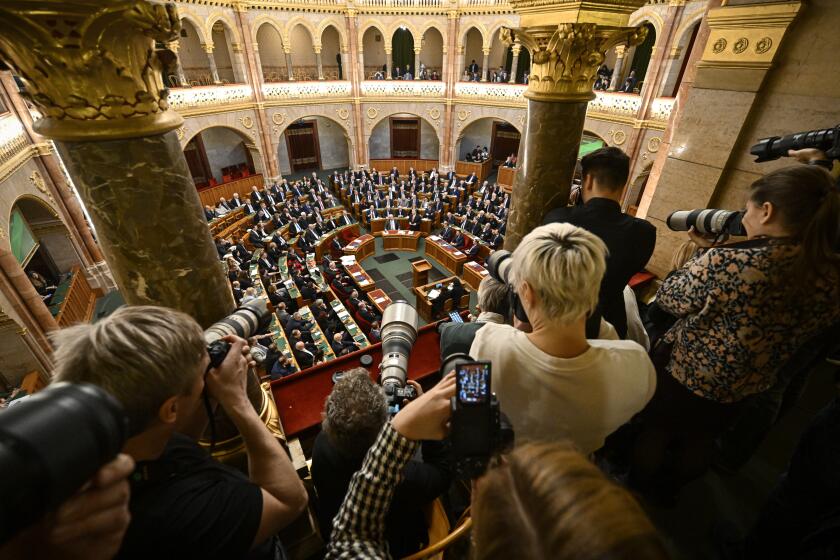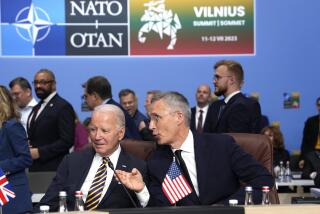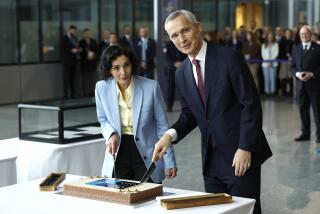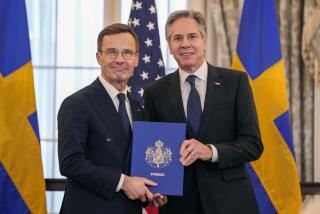As Sweden joins NATO, it bids farewell to more than two centuries of neutrality
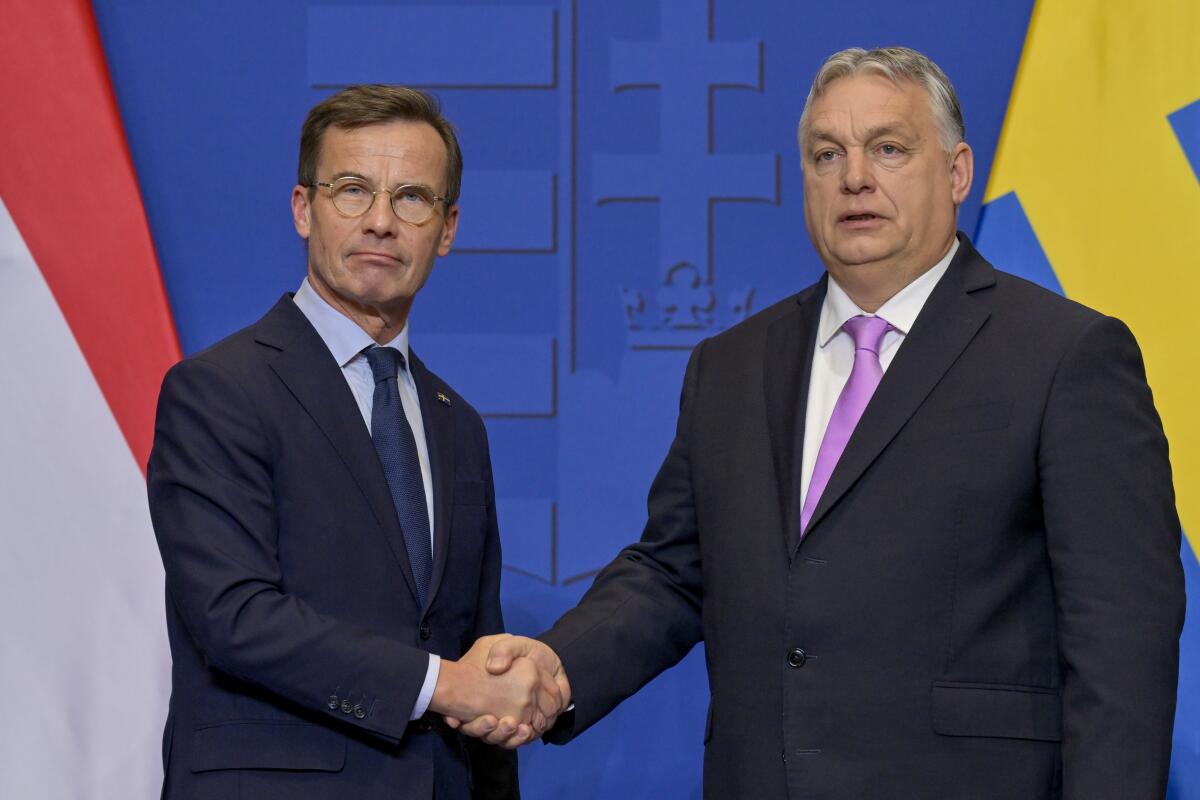
- Share via
STOCKHOLM — Sweden’s last war ended in 1814, and when the rifles and cannons it aimed at Norway fell silent, the once-warring power would not take up arms again.
For the next two centuries, Sweden embraced a policy of neutrality, refusing to take sides in wars or join any military alliance. It was a stance that kept peace at home and contributed to the country becoming a prosperous welfare state and humanitarian superpower.
This remarkably long era of nonalignment is coming to a close as Sweden joins NATO. The ceremonial formalities are expected soon, after 18 months of delays while Turkey and Hungary held up ratification and sought concessions from other members of the alliance.
“Sweden is now leaving 200 years of neutrality and nonalignment behind us,” Swedish Prime Minister Ulf Kristersson said after Hungary’s Parliament gave its approval Feb. 26, overcoming the final hurdle. “It is a big step. We must take that seriously. But it is also a very natural step that we are taking.”
Hungary’s parliament has ratified Sweden’s bid to join NATO, bringing an end to more than 18 months of delays that have frustrated the alliance.
Sweden, like neighbor Finland, had long ruled out seeking NATO membership. That changed practically overnight when Russia launched its invasion of Ukraine in February 2022. The attack sparked fears across Europe of Moscow’s revived imperial ambitions — alarm that has grown as Russia gains momentum on the battlefield in Ukraine.
“It’s the right path for us,” said Jacob Frederiksen, a 24-year-old pilot, who like many Swedes has embraced NATO membership amid the breakdown of the post-World War II order that largely kept the peace for decades. “I think in this new era, it’s better to be part of an alliance than being independent and neutral.”
The invasion “had a shock effect on Swedish political life,” said Henrik Ekengren Oscarsson, a political scientist at the University of Goteborg. He analyzed polling data showing that support for NATO membership surged from 35% in 2021 to 64% after the invasion.
“It was the largest and fastest shift in opinion that has so far been measured in Swedish political history,” Ekengren Oscarsson wrote.
In a Ukrainian village, a woman wants only one thing: to find her husband, who disappeared shortly after Russia’s war on Ukraine started two years ago.
Still, new anxieties come with being part of an alliance amid rising tensions between Russia and the West.
Ulrika Eklund, a 55-year-old bank employee in Stockholm, said she feels uncertainty about being in NATO and the effect it will have on Sweden. But she understands why the step has been taken with “so much going on in the world and in Europe.”
The country’s neutrality has its roots in the early 19th century, when Europe was engulfed in the Napoleonic wars.
Though Sweden ended up on the winning side of battles against France’s warrior-emperor Napoleon Bonaparte, the loss of territorial possession in Finland to Russia years earlier put an end to any illusions of Sweden continuing in a big-power role.
“After having gained Norway, the policy was aimed at staying outside the quarrels of the big powers and instead developing Sweden as a country. And that we did,” said Robert Dalsjö, senior analyst with the Swedish Defence Research Agency.
The policy allowed Sweden to grow, Dalsjö said, putting it on the path to a modern state after being “one of the poorest and most backward countries in Europe in the early 19th century.”
As Sweden adjusted to its new status, King Karl XIV Johan declared the country’s neutrality in 1834. In a letter to the courts of Britain and Russia, he urged respect for Sweden’s wish to stay out of their conflicts.
Preserved in the Swedish National Archives and considered the oldest document on Sweden’s neutrality, the text reads: “We will request, as we do now, to stay totally outside of this struggle, and that Sweden and Norway, by keeping a strict neutrality towards the warring parties, can deserve, by our impartial conduct, respect and the appreciation of our system.”
Along the way, Sweden’s neutrality was tested — particularly during World War II, when it made concessions to Germany to stay out of war.
“The Second World War was a near-death experience for Sweden,” Dalsjö said.
Many Swedes believed they remained at peace due to their neutrality, he said, but in reality “we were flexible in our application of neutrality: early in the war, making concessions to the Germans and later in the war, making concessions to the allies.”
During the Cold War, when Sweden and Finland were buffer countries between NATO and the Warsaw Pact alliance, many Swedes — and Finns — felt that being outside either bloc was the best way to avoid tensions with Russia, the powerful eastern neighbor in the Baltic Sea region.
But that never meant a full embrace of pacifism. In the 1950s and ’60s, Sweden had the fourth-largest air force in the world and the ability to mobilize around 800,000 men, including reservists, in case of war, said Andreas Ohlsson, curator at the Swedish Army Museum.
“Being neutral is not being naive. It’s actually a way of thinking that we have to be self-dependent if the war comes,” Ohlsson said.
As the years passed, the idea of Sweden as a voice for peace and nuclear nonproliferation became core to Sweden’s identity. The home of the Nobel Prize institutions funded foreign aid programs, took part in peacekeeping missions abroad and relied on its neutral status to act as a mediator in regional conflicts around the globe.
Olof Palme, Sweden’s prime minister in the 1970s, described Sweden as a moral superpower that should “become active in situations where other countries, as a result of their foreign policy stance, have been incapable of engagement.”
Fears of Russia’s military power stretch back centuries and lasted into the twilight years of the Cold War. In 1981, a Soviet submarine ran aground in the Stockholm archipelago, coming close to the main Swedish naval base. Tense days followed.
After the Cold War, fears diminished, and Sweden cut back on defense spending. But in recent years, Sweden has invested more in its military and built up contacts with NATO, participating in training with the alliance.
A key catalyst was Russia’s annexation of Ukraine’s Crimean Peninsula in 2014.
In 2017, Sweden brought back conscription. The next year, a regiment on Sweden’s strategically important Baltic Sea island of Gotland, northwest of the Russian territory of Kaliningrad, was reestablished after being disbanded in 2005.
Over time for Sweden — clearly rooted in the West and a member of the European Union since 1995 — the word “nonalignment” became more apt than “neutrality.”
“For 30 years, we have edged away from the pure-hearted neutrality that was never so pure, to an alliance position,” Dalsjö said. “And you might say that we finally consummate it by joining NATO.”
More to Read
Sign up for Essential California
The most important California stories and recommendations in your inbox every morning.
You may occasionally receive promotional content from the Los Angeles Times.
